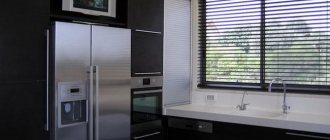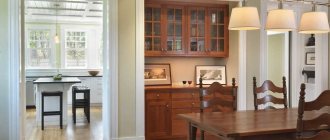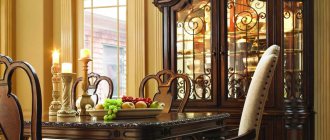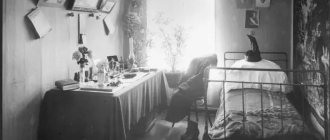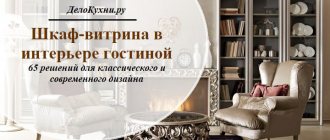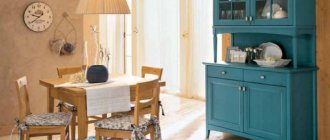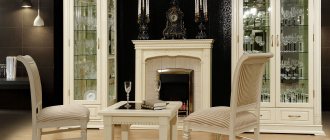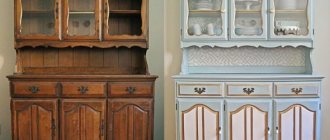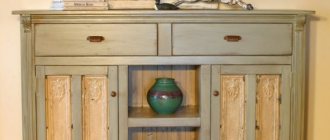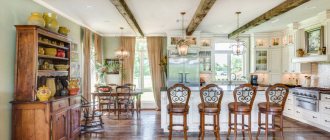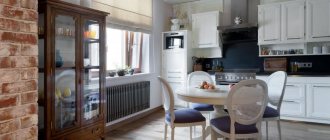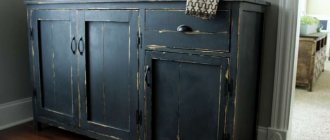In a dining room or living room that is equipped with a dining area, it is desirable to have beautiful and functional pieces of furniture for storing dishes, textiles, and serving utensils. It is important to choose models so that they are spacious, ergonomic, aesthetic, and also fit harmoniously into the interior concept. For small rooms, a compact cabinet, display case or credenza is ideal; for a spacious room you can buy an antique buffet or sideboard. An unobtrusive touch of vintage gives the products a special chic. Credenza is a chest of drawers adapted for dishes, on a small surface of which you can afford serving for a cozy feast. To display beautiful dishes, there is a showcase, the structure of which is almost entirely made of glass. But the slide combines closed closed cabinets in the lower part and transparent sides and facade in the upper part. It is worth dwelling in more detail on the description of the buffet and sideboard - charming immigrants from medieval France.
Cupboard sideboard for dishes - design and features
In the modern model of the sideboard, few people recognize the same element of the furnishings of the Soviet period. Its functionality has increased noticeably, but, as before, it is easy to recognize by its design features:
- Massive lower part with legs. Always closed with blind doors. Externally it looks like a floor mezzanine. It can resemble a TV stand and be placed directly on the floor without legs;
- Upper tier. It has a smaller width than the bottom. Most often it is decorated with glass doors and shelves for dishes or decoration.
Types of sideboards by design
Modern or ancient models of buffets can be divided into several types according to their design. There are stationary, hanging and corner sideboards that can be placed in any room that suits the style.
Stationary sideboard
A classic stationary buffet can consist of the following parts:
- main part. There are shelves covered with glass or other material. On display cases you can place dishes, figurines and other beautiful objects that will be visible to the human eye. On the sides, the sideboard can be open for viewing or closed - deaf;
- Bottom part. At the bottom of the product there are always drawers or cabinets. This area is made closed so that the user has the opportunity to store other things, for example, tablecloths, napkins, dishes for salads, snacks. Some models are equipped with both drawers and cabinets.
Stationary products must have legs: they can be carved, hidden or made in a modern style - chrome-plated.
Hanging buffet
Sideboards designed to be hung on the wall are best placed in the kitchen. Here such a piece of furniture will take its place - it will fit perfectly into the work area of the kitchen or dining room. The design of the classic wall-hung style buffet consists of shelves, doors and side windows for viewing. Some models are produced in a combined form - there are doors on top, and drawers just below. They can be used to organize the storage of small items - cutlery or dish towels.
Corner buffet
Corner sideboards are well suited for filling empty corners of a room. Designer models can be divided into several types:
- semicircular - models where there are no corners in a visible place. The buffet is opened by sliding doors or by pressing the glass;
- pentagonal - the most common type. The products are made from solid wood, they look respectable and have a high cost;
- with additional shelves - several sections are used to store dishes, another one is equipped with open shelves where you can put books and decor.
The sideboard is selected based on the color design and interior style. For modern designs, metal models and glass options are suitable. If the interior is made in a vintage style, it is better to purchase a sideboard made of wood.
What is the difference between a sideboard and a buffet?
The older relative of the tableware sideboard is the buffet. It has been known since the 16th century, but received its characteristic appearance in the 17th century. It was from this period that it began to be produced in the form of a set:
- Lower tier with doors. Very reminiscent of an ordinary modern kitchen cabinet. Only the sizes are larger. Also equipped under the tabletop with one or more drawers for cutlery;
- Central niche. It can be designed in different ways, but its main task is to separate part of the buffet space for cooking or serving;
- Upper section with shelves. The third tier of the buffet is intended for display and storage of dishes. It can be open with crossbars or closed with glass doors.
The functionality of the model was so to the taste of the housewives that the buffet very quickly conquered the whole of Europe. However, in most countries nothing was changed in it at all. To this day, you can find this furniture in almost unchanged form in French kitchens. In our country, a buffet is also not a rare guest in kitchens. This is due to the small size of most kitchens. But along with other types of cupboards, it is often installed in the hall.
It is by the presence of the notorious central niche that it can be distinguished from a sideboard. Otherwise they can be almost identical. Modern buffet models are most often part of furniture sets. May be accompanied by a pair of glazed side cabinets or sections with open shelves.
War and Peace: credenza, sideboard, sideboard and showcase - where to put them?
Thanks to its design, which turned out to be so rational and convenient that no one wanted to redo it, the buffet has survived to this day unchanged. It is easy to identify: the top has glass doors, the bottom has solid doors, and in the middle there is an open niche with a table top and drawers underneath. Sometimes they can complement the upper cabinet tier of the buffet.
The upper cabinets usually contain drinking glass and dear tableware, which you are not ashamed to show to guests. In the lower ones there are table textiles, serving items and some products. The drawers contain cutlery, and everyone uses the niche above the table in their own way, trying to give it a decorative character.
Previously, in Russia a samovar and a copper bowl for jam were placed here, in Germany - large beer mugs, and in France - bottles of wine. Be that as it may, it is the tabletop with a niche that is the main distinguishing feature of the buffet. If it’s not there, it’s definitely not him, but a completely different piece of furniture. For example, like the one in this photo.
Although the manufacturer or seller called it a sideboard, in fact we see a lovely sideboard in the spirit of good old country. Of course, there is a place to store wine in it, but there is nowhere to uncork bottles and put snacks - there is no countertop. It was never in the sideboards, since they are not intended for the dining room.
The most valuable thing is in the sideboard
The sideboard is an invention of the French, a child of pampered Rococo, which swept across Europe in a wave in the 20-70s of the 18th century and left a bright mark on the art of interior design, furniture, dishes and other household items.
Large three-section sideboard in Rococo style, modern model
By the time the sideboard came on the scene, the sideboard was the center of the family's wealth, or, in any case, a reflection of its wealth. But “representative” functions were not the strong point of the buffet worker. Of course, he served not only family dinners, but also dinner parties, which always took place in the dining room. But they didn’t take place every week. But in the living room, where drinks and desserts were served, guests were received every day.
There was, of course, a credenza. However, it was not enough to demonstrate all sorts of status items, of which quite a few appeared then. The room, which became the main representative center of the house, required a new type of furniture. The furniture makers did not rack their brains for long and, in response to the request, offered a sideboard.
Essentially, it was a buffet without a table or niche. Having removed them, the craftsmen increased the size of the upper glazed tier, and the function of the item changed radically: from serving to exhibition, from practical to decorative.
Based on the decoration and contents of such a cabinet, each guest could get an impression of the taste, erudition, social status and capital of the family. Just as by the appearance and manners of domestic servants, they then judged the integrity of the house and whether its owner knew how to conduct business. Perhaps this is where the name of the new furniture comes from: “servante”, which means “maid, servant”.
Sideboards began to display decorative vases, art glass, faience and biscuit figurines, elegant bonbonnieres and Bibelots (snuff boxes), which often served as gifts. The price of all these “trinkets” was very high. Not to mention the newfangled porcelain dishes, the secret of which was discovered by Europeans just at that time - the sets cost a fortune. And master furniture makers made cabinets to match them, using carvings, inlays and expensive materials: precious woods, mother-of-pearl, non-ferrous metals.
Of course, such furniture and everything it contained were initially available only to incredibly rich people.
Sideboard history and evolution
Initially, the sideboard was purely kitchen furniture. It was a wide cabinet with doors. The sideboard was made as high as an ordinary table. Table linen was stored downstairs. Silverware was placed in small drawers under the tabletop. A little later, the sideboard acquired a second “floor”. So they began to add an upper closed mezzanine for plates. But it had rather modest dimensions.
It gained enormous popularity in our country during the heyday of the USSR. It looked almost the same as at the time of its appearance, but it was during Soviet times that it began to be equipped with an internal rear mirror, glass shelves and was moved to living rooms. In addition, it was made much wider than originally intended. The sideboards have become huge and have grown significantly. If it was originally conceived as a table, then in the Soviet Union it was already more like a cabinet. Not only in height, but also in dimensions. Also during this period, the difference between the top and bottom in area disappeared. It was a rectangular “box” on legs with glass shelves.
Today, the sideboard is still more of a living room furniture item. This is understandable. It began to be equipped not only with glazed doors on the upper part, which made it possible to beautifully arrange the dishes. A modern sideboard can be equipped with a built-in bar, a niche for a TV and is a smaller analogue of a slide. Although, it is starting to resemble the earlier versions more and more.
What does credence look like?
Cabinet furniture for the kitchen, consisting of drawers, as well as compartments with a hinged door mechanism. Its basis is a chest with doors resting on legs. The item is convenient for saving cutlery and dishes.
Predominance of black, red, white shades
A low cabinet that looks like a chest of drawers. The legs are slightly higher than those of the sideboard. The color matches the color of the bench and the floor surface. Such furniture can be part of the interior of a dining room or living room.
The tabletop serves as a surface for prepared dishes before serving them to the table.
Spectacular finishing of the side surfaces of the hall
The elegant credenza fits well into the modern interior. The room looks absolutely great. All objects in the room contrast with the rich color of the walls.
The stunning antique design looks very appropriate and respectable. It can be successfully placed in the living room, as well as on the platform between floors in a mansion or apartment. There it will serve as a convenient chest of drawers.
Gray-blue upholstered furniture
The central wall of the living room is occupied by an original long cabinet. It is low, made of natural wood, slightly elongated horizontally. You can put various necessary things in it.
Design features of sideboard cabinets for dishes
Top part
Since the upper part of the sideboard appeared much later, it was this part that underwent the greatest changes. At first it looked like a smaller version of the bottom. Another small cabinet with blank doors was simply attached to the top. Then the doors began to be made of glass. This allowed the sideboard to become not just a kitchen cabinet, but to quietly migrate into the living rooms. Even in Europe, not everyone could afford classic tableware display cases designed for living rooms. The sideboard has become a good budget alternative.
Traditionally, the top of a home sideboard is equipped with:
- Several shelves for dishes. They can be made of glass or base material. Their size directly depends on the dimensions and number of sections. The number varies from 2 long ones to several dozen miniature ones;
- Doors. Currently, they are made strictly of glass;
- Rear mirror. This fashion has taken hold and it is often installed today.
All glass used in production can be classified as float. This is a hardened, polished blade that is uniform throughout its thickness. No defects are allowed. It can be made from both natural crushed quartz and synthetic. It can be transparent and colorless. If the thickness of the cut gives a tint (green, bluish), then this is transparent glass. Colorless will not have this effect, so it transmits light better. Most often it is also equipped with shockproof films. If such glass is broken, there will be practically no fragments. It will simply crack, but will retain its shape.
It is the glass doors that will play a huge role when fitting a sideboard into the interior:
- Lightened. Transmits over 50% of light. Provides an amazing view with soft natural lighting;
- Matted pattern. Will bring originality. Performed using sandblasting method;
- Dairy. The glass is etched with acid until it partially or completely loses its transparency. It will look good in combination with traditional transparent;
- Tinted. Another way to add originality to your design. Give preference to warm shades of bronze and gold;
- Stained glass film. Each fragment of the pattern is framed by a thin metal profile. Everything looks voluminous, expensive and stunningly beautiful. Simply stick to the surface of the sash.
There are several options for the door opening system:
- 2 doors. They can be hinged or move sideways in special grooves;
- 3 doors. Most often, they will all be sliding. Or 2 sliding and 1 swing;
- 4 doors. There will also be either all sliding ones or in combination;
- 6 doors. There are sliding doors at the top, and 3 folding ones underneath.
Bottom part
The lower part is a system of shelves and drawers. Designed for storing various things or everyday utensils with frequent use (for kitchens). Always supplied with solid doors. They can also be decorated:
- Thread. An excellent option for wooden models. Allows you to create a three-dimensional drawing of any shape and complexity;
- Milling cutter. This method is more suitable for particle board models. Allows you to apply relief patterns without damaging the structure of the material;
- PVC films. A wide range of textures will allow you to update the design of your doors at minimal cost. It won't last very long. Easy to re-glue;
- Hand painted. Add some variety to a boring wood background;
- Decorative strips. They are easy to glue into the desired shape. Looks good with minimal cost.
Materials for manufacturing can be:
- Wood. A very expensive pleasure;
- Fiberboard. The boards are pressed from strand fibers. Quite soft;
- Chipboard. Sawdust is pressed into layers with heating. Looseness depends directly on the size of the sawdust;
- MDF. The densest, since they are made from wood waste of the smallest fractions.
A little less often, these boards can be found in a varnished version (LMDF, laminated chipboard).
How to choose?
Let’s take a closer look at the most popular modern and classic models and try to make a choice.
White sideboard
Furniture for dishes in light shades is suitable for a living room in Provence style. However, the white version will fit perfectly into other style trends, although it is worth considering a few nuances. For example, if the design is made in a classic style, then light furniture must certainly be of high quality. A white cabinet can be a good design solution when arranging a small living room, especially if it has glass doors - the light transparent design will visually expand the space.
If a sideboard is purchased for a luxurious large living room, then it is recommended to choose massive white pieces.
Another option for a small area is a white single-leaf sideboard.
Modern sideboards are very convenient, equipped with transparent doors on top and closed drawers on the bottom. In this case, the dishes are on display, and below you can hide household unaesthetic things like tools or office supplies. Be sure to check the reliability of the shelves and their capacity before purchasing.
Classic sideboard
This design is similar in appearance to a traditional sideboard and is usually used in classic living rooms. The difference from a standard buffet is the presence of additional compartments for storing dishes. If you need to choose a classic sideboard, then take into account the manufacturing elements: the upper part should be equipped with glass doors; the traditional model does not have glass at the bottom.
This is a spacious cabinet, but large dimensions are uncharacteristic for it: the maximum allowable height and width is 2 m.
Modern classic models always look solid and noble, even if they are made not of expensive wood, but of chipboard. Although, of course, natural materials look more luxurious and last longer. However, elite wood is more demanding in terms of maintenance. If the cabinet is made of inexpensive raw materials, then you can decorate it with unusual patterns and figures on the transparent doors. It is also possible to purchase a classic example with backlight.
Corner sideboard
This model is recommended for buyers who own a very small living room. A corner cabinet takes up very little space and allows you to make good use of a corner where it is usually difficult to fit anything. A special feature of corner models is the ability to display the most beautiful dishes in small quantities - a corner display case is not suitable for storing an abundance of tableware.
Designs for small living rooms have a purely “symbolic” angle, they are narrow and elongated in height, but there are also models for spacious rooms.
The corner sideboard is smaller in size than the classic one, and when ordering the product, it is recommended to add special drawers and shelves to it. This is a very convenient design that can become not only a functional piece of furniture, but also a decorative one. Corner models fit well into both classic and modern interior styles. You can decorate the corner cabinet with carvings or interesting ornaments. Manufacturers offer wenge color options or varnished sideboards.
Wooden display cabinets
An attractive and functional design that can be made from both expensive and artificial materials. Beautiful dishes look very elegant if they are neatly arranged on the sideboard display. When choosing such a model, be sure to consider the size of the product and its compliance with the parameters of the living room. For a small room, do not choose a bulky structure and, on the contrary, refuse a miniature cabinet when arranging a spacious area. Make sure the shelves are sturdy and can support heavy dishes.
Display cabinets are always equipped with transparent glass in the front part. When purchasing, it is recommended to give preference to items with impact-resistant glass. These designs come in a variety of colors - make sure the pattern you like suits your living room style.
For a review of the classic sideboard for dishes, see below.
Shapes and sizes of sideboards for dishes
The height of a standard sideboard can vary from 1.5 to 2 meters. At the same time, its width does not exceed 2 meters (maximum value). The standard depth for the top is 30 cm, and for the bottom - 50 cm. However, this is just a cliché. When making to order, the specific features of your room will be taken into account.
There are also several types according to shape:
- Classic. There are legs. The top is narrower and thinner than the bottom;
- Floor. Has no legs;
- Corner sideboard. The interior space looks like a triangle. Quite a complex option for dishes. But the corner version looks very nice. Allows you to save valuable meters of usable space;
- Mounted. The lower massive part is missing. At the bottom you can place a wide cabinet;
- Modular. It is assembled from separate modules like a constructor. A unified stylistic orientation allows, by rearranging several modules, to update the appearance of the entire ensemble;
- Ostrovny. No top. Used for serving and demonstrating food and drinks.
Installation and maintenance of kitchen cabinets
The kitchen area is exposed to moisture and fumes when cooking, so you should select furniture from high-quality materials.
There are general rules for caring for kitchen cabinets :
- do not place the sideboard in direct sunlight;
- make sure that moisture or condensation does not accumulate on surfaces;
- It is better to wipe plastic panels with a damp cloth, wooden panels with a dry cloth;
- When cleaning, do not use aggressive detergents;
- for deeper cleaning of wooden surfaces, use a cloth soaked in water with a degreasing solution diluted in it;
- It is better to wash stainless steel parts with soapy water and then wipe with a dry cloth;
- avoid impacts and mechanical damage;
- Do not place cabinets above the hob.
If we talk about glass for display cases , then they must be at least 4 mm thick, durable and tempered. Consider installing interior lighting - it will highlight the beauty and elegance of the furniture.
Freestanding kitchen cabinet
Installation of a sideboard depends on the features of the kitchen .
If it is combined with the living room, the cabinet will look good in the dining area. You can place it near the dining table, opposite the entrance to the kitchen. There are options when the sideboard consists of linear and corner modules. In such cases, one is placed in a corner and the other against the wall. At the same time, a table, chest of drawers, compact sofa or lounge chair can easily be placed between the modules.
In a small kitchen, a sideboard is placed so that it does not upset the balance of the working triangle with the vertices - the refrigerator, stove and sink.
If there is space opposite the linear arrangement of the kitchen unit , it should be used specifically for installing a sideboard.
Advice. Furniture should not interfere with movement around the kitchen. It can be built into the wall opposite the dining area or to the side of it.
In a small apartment, it is more logical to install a sideboard that will serve more of a decorative function . Souvenirs, art and decor items are placed on the shelves. The cabinet is placed in such a way that it receives as much light as possible, or is equipped with artificial lighting.
Using a sideboard, you can zone the living room space, separating part of the dining room from the area where the upholstered furniture is located. Two corner cupboards will look interesting at the edges of the living room, with a fireplace, chest of drawers or TV stand between them.
Narrow sideboard for the kitchen
A narrow sideboard for the kitchen, or as it is commonly called, a pencil case, is an ideal solution for a small apartment .
Classic options are usually tall, but there are no clear size requirements. These cabinets are uniform in shape, although there are also original models, for example, a semicircular corner sideboard. Its interior is spacious due to the very corner of the room. They install narrow sideboards in any empty niche and complement the existing kitchen set with them. Keep in mind that the pencil case should match the style and color scheme of the rest of the furniture as closely as possible. However, options are also allowed that look like an accent in the interior design. For example, in a plain white kitchen a bright, antique or artificially aged sideboard will look impressive.
On small square meters, a built-in narrow sideboard not only serves as decoration , but also has many functions. Below, behind blank doors, they hide a dishwasher or mini-fridge. The upper cabinet is used to store dishes and figurines.
Sideboard in a modern style
A sideboard in a modern style does not imply elaborate decor and decorations .
Basically, such products are distinguished by clear lines, an abundance of glass and the presence of metal fittings. This means that if the kitchen is designed in high-tech, minimalism or modern style, then you can choose a sideboard for it. In a Scandinavian interior, it is appropriate to use a white sideboard. There will be nothing superfluous in it; the only decorations will be chrome legs and handles.
The main feature of a modern sideboard is its functionality: many pull-out and folding drawers with closers. There are also cabinets that have a bar function. Such options are ideal for studio apartments, as they can act as a false wall, delimiting the space.
A modern sideboard looks best in the same color scheme as the rest of the furniture . Therefore, pay attention to the facades. There are also often models that do not provide clear distinctions between the upper and lower parts and do not have empty space in the middle. Such specimens look like showcases, on which modern bright dishes look good.
Rules for placing dishes in a sideboard
By tradition, only the best examples of tableware are put up for review. How to place it depends only on your imagination. Although, there are a few rules:
- When placing glass and tableware at the same time, place the porcelain in the center;
- Larger items are installed behind smaller ones;
- Do not mix tea or coffee sets with glass or crystal. This is bad manners;
- Colored porcelain (glazed) is displayed separately from white;
- To increase capacity, plates can be placed at an angle. At the same time, this improves the appearance of the displayed service;
- Only the smallest flat plates or saucers can be placed in stacks. In this case, the size of the stacks should not be too high.
If you use cookware frequently, then there is little point in putting it up for review. You get tired of regularly adjusting the composition. And the appearance of constantly used dishes is noticeably worse than that of new ones.
Where can sideboard cabinets be installed?
If the size of the kitchen allows you, then such a pleasure will add sophistication to the atmosphere. But, since such spaciousness is rarely seen in domestic kitchens, feel free to send the sideboard to the living room. It is there that he will reveal all his best properties. You can choose a model with a niche for equipment and make it the central element of the decor. In this case, it is better for you to choose a modular option with additional pencil cases, a display case or wall shelves (island).
Multifunctional cabinet
There are also options for a sideboard cabinet. Absolutely everything should be stored in it, even bedding. This wardrobe is convenient and comfortable, no different from a regular wardrobe in terms of convenience and spaciousness. This option looks very impressive.
Recently, sideboards designed for alcoholic beverages have become extremely popular. Such a cabinet is placed in the hallway, living room or kitchen and bottles of expensive alcohol are displayed in it, flaunted as if in a shop window.
The sideboard completely replaces the bar counter. Place glasses for guests in a hollow niche, and move comfortable high chairs nearby. The home bar is ready.
Caring for your sideboard is incredibly easy, just like any other piece of furniture in your home. It is recommended to protect this piece of furniture from direct sunlight and wipe dust on it (for this you should use any furniture polish containing resins and an antistatic agent).
Don’t forget to wipe the dinnerware sets, wine glasses and glasses inside the sideboard so that they always shine and look great, just like in a real display case.
A sideboard is a convenient thing, necessary in every home. A multifunctional cabinet, used as an option for storing various things, spacious and attractive in appearance. Decorate your home and make your life easier with extensive cupboards.
Styling and decor
To correctly fit a sideboard into the interior, you should choose it based on the stylistic orientation:
- Classic. Correct silhouette, strict contours. Symmetry is observed in the furniture itself and its arrangement;
- Minimalism. Regular cubic shapes without excess decoration. The decoration can be an unusual design. For example, an option where the glazed part is located in the center of a rectangular sideboard (similar to a large aquarium). The style is for everyone, keeping up with modern trends;
- Palace styles. Sideboard and all its relatives come from this era. It was the Baroque and Rococo styles that gave rise to the most beautiful and sophisticated options. Bent legs, carvings, gilding, porcelain overlays with painting. The styles are renowned for their sophistication and fluidity of form;
- Ethnic orientations. An oriental style sideboard in the shape of a polyhedron with openwork carved doors will create a unique flavor for the interior. You can also choose a design with different directions of hand painting (Zhostovo, Palekh, Khokhloma). To complete the picture, place appropriate items inside. Remember, ethnic style involves decorating the entire room in one direction. Single elements of the furnishings will either blur the overall impression or get lost in the interior;
- Vintage. This style involves the recreation of a certain historical period. Hand-finished furniture and individuality are encouraged. You can use methods of artificial aging, decoupage (pasting with colored napkins), and hand painting. The rest of the setting should be in the spirit of the same time period.
External gloss of sideboards
Beautiful sideboards are usually made in the Baroque style. Gold trim or mirror inserts are often used. This kind of furniture looks expensive, there is no rich interior that would not fit into an unusual, original sideboard.
Black cabinet: 78 photos of the benefits of using black furniture in interior design- IKEA cabinets - 150 photos of new designs from IKEA. The most popular series, collections and lines
Wardrobe in the living room - popular trends in design and use in the interior (99 photos)
Photos of sideboards
<
>
After people forget a thing well, it becomes a fashionable novelty. This is exactly what happened with the sideboard. After decades of neglect, demand for these functional and beautiful china cabinets has risen again.
How to make a sideboard?
In addition to restoring old furniture, you can make your own sideboard from scratch. It will fit perfectly into any interior, creating coziness. To do this, you need to prepare beams that will serve as a vertical support for the two parts of the sideboard.
Next, you will need several boards that will form the basis of the cabinet. Make several sashes, attach them to the beams, then build something like a cabinet on which these sashes will be installed. Connect all the parts together. In general, armed with a plane and other tools, you can create wonderful things.
